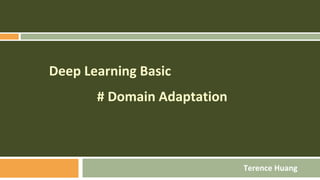
Deep Learning Advance: #01 Domain Adaptation
- 1. Deep Learning Basic # Domain Adaptation Terence Huang
- 2. Abstact • Paper - (2014) Unsupervised Domain Adaptation by Backpropagation • Abstract - 改善 train, test 相似但有些差異時預測效果不好 - 使用 Domain adaptation 概念結合 Adversarial neural network 架構執行 • 可適用任何 neural network 2 train test
- 3. Outline • Domain Adaptation • Adversarial neural network • Experiments - 數字分類 - Train 時額外提供少量標記的 test set 3
- 4. Domain Adaptation • Domain Adaptation - 實際問題: Train set 預測模型對有些差異的 test set 預測效果不好 - 解決方式: 將取出的 train 和 test feature 做 adapted • 對 feature 做非監督轉換 • 使用 Adversarial neural network 同時做 轉換 & 預測 4 Label (y) ML Domain (d) 有 Train Source 沒有 Test Target What is feature extraction
- 5. Adversarial neural network • Forward 5 features𝑓 class label 𝑦 domain label 𝑑 ⋮ feature extractor 𝐺𝑓 ; 𝜃𝑓 domain classifier 𝐺 𝑑 ; 𝜃 𝑑 label predictor 𝐺 𝑦 ; 𝜃 𝑦 Need more explain
- 6. Adversarial neural network • Backward / Backpropagation 6 class label 𝑦 domain label 𝑑 ⋮ 𝜕𝐿 𝑓 𝜕𝜃 𝑓 Loss 𝐿 𝑓= 𝜕𝐿 𝑦 𝜕𝜃 𝑓 − 𝜆 𝜕𝐿 𝑑 𝜕𝜃 𝑓 𝜕𝐿 𝑦 𝜕𝜃 𝑦 Loss 𝐿 𝑦 𝜕𝐿 𝑑 𝜕𝜃 𝑑 Loss 𝐿 𝑑 features𝑓
- 7. Adversarial neural network • Backward / Backpropagation - Adversarial - Domain classifier 跟 label predictor feature extractor 互相對抗 - Domain classifier 會幫助 label predictor 預測效能 7 Goal 2: 各別任務 loss 越小越好Goal 1: 整體 loss 越小越好 ! ! min 𝜃 𝑦 𝜕𝐿 𝑦 𝜕𝜃 𝑦 & min 𝜃 𝑑 𝜕𝐿 𝑑 𝜕𝜃 𝑑 min 𝜃 𝑓,𝜃 𝑦,𝜃 𝑑 𝜕𝐿 𝑦 𝜕𝜃𝑓 − 𝜆 𝜕𝐿 𝑑 𝜕𝜃𝑓 Need more explain
- 8. Adversarial neural network • Backward / Backpropagation - 藉由控制 𝜆 來調整訓練早期的雜訊 • 𝜆 𝑝 = 2 1+exp(−𝛾⋅𝑝) − 1, 𝜆 ∈ [0,1], 𝑝 ∈ Linear[0,1], 𝛾 = 10 - SGD, standard stochastic gradient solvers, fail • 𝐿𝑦 和 𝐿 𝑑 方向不一 • 無法由反向傳播更新 - GRL, gradient reversal layer, success • 引入 pseudo-function R 𝜆(𝒙), 允許在 loss 往前傳時多增加一層叫做 gradient reversal layer 設計 Forward: 𝑅 𝜆 𝒙 = 𝒙 Backward: 𝑑𝑅 𝜆 𝑑𝒙 = −𝜆𝑰 • 就可以再度使用 SGD Goal 1: 整體 loss 越小越好 min 𝜃 𝑓,𝜃 𝑦,𝜃 𝑑 𝜕𝐿 𝑦 𝜕𝜃𝑓 − 𝜆 𝜕𝐿 𝑑 𝜕𝜃𝑓 8
- 9. Experiments - 數字分類 Source Methode Target Source only 下界 0.5749 0.8665 0.5919 0.74 Sa (fernando et al., 2013) 比較 0.6078 (7.9%) 0.8672 (1.3%) 0.6157 (5.9%) 0.7635 (9.1%) Proposed approach 本篇 0.8149 (57.9%) 0.9048 (66.1%) 0.7107 (29.3%) 0.8866 (56.7%) Train on target 上界 0.9891 0.9244 0.9951 0.9987 Brackets: much of the gap between the lower and the upper bounds was covered 9
- 11. Experiments - Train 時額外提供少量標記的 test set 11 • Semi-supervised domain adaptation - When one is additionally provided with a small amount of labeled target data • GTSRB data only • Synthetic data only • Both Synthetic + 1280 筆 GTSRB (隨機, 提供標註)
- 12. Recall • Paper - (2014) Unsupervised Domain Adaptation by Backpropagation • Abstract - 改善 train, test 相似但有些差異時預測效果不好 - 使用 Domain adaptation 概念結合 Adversarial neural network 架構執行 • 可適用任何 neural network 12 train test
- 13. Other • GAN vs. Domain Adaptation - GAN: generative adversarial network 13 1. 把 Classify 任務 改成影像生成 2. 把 Domain Classify 任務 改成是否為生成區分 Note. 生成的影像只能走下面那條 GAN 對 DA 做什麼
- 14. Q&A Thanks for your attention! 14
- 15. Other • Transfer learning vs. Domain Adaptation 15
- 16. Feature extraction • Feature extraction 16 Back Feature extraction
- 17. Adversarial neural network • Forward 17 Label (y) ML Domain (d) 有 Train Source 沒有 Test Target Back
- 18. Adversarial neural network • Backward / Backpropagation 18 Label (y) ML Domain (d) 有 Train Source 沒有 Test Target Back
- 19. Adversarial neural network • Backward / Backpropagation 19 Label (y) ML Domain (d) 有 Train Source 沒有 Test Target 𝐿 𝑦 𝐿 𝑑 𝐿 𝑦 − 𝜆𝐿 𝑑 Back
- 20. Adversarial neural network • Backward / Backpropagation 20 Label (y) ML Domain (d) 有 Train Source 沒有 Test Target 𝐿 𝑦 = 0 𝐿 𝑑 −𝜆𝐿 𝑑 Back 0
